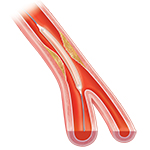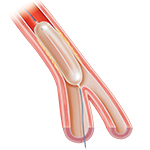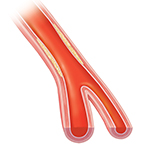Peripheral angioplasty is a procedure that helps open blocked arteries in the legs and arms (peripheral arteries). These blood vessels may become blocked by plaque. This prevents blood from flowing normally. The procedure can help improve the blood flow.
Before the procedure
Do the following:
-
Tell your healthcare provider about all medicines you take. This includes prescription and over-the-counter medicines. It also includes vitamins, herbs, and other supplements. Tell your provider about any allergies you may have. Tell them if you have an allergy to iodine, or to latex or rubber products.
-
Follow all directions you are given for not eating or drinking before the procedure.
-
Arrange for a family member or friend to drive you home.
During the procedure
-
You may get medicine through an IV (intravenous) line to relax you. You will then have a shot (injection) to numb the area on your body where the procedure is done. This is often an artery in the groin. Or an artery in your wrist or arm may be used instead.
-
The provider makes a tiny skin cut (incision) near the artery.
-
They put a thin, flexible tube (catheter) through the incision. They then thread the catheter into the blocked artery. This is done using X-ray guidance. The X-rays are used to help show where to put the catheter.
-
Contrast dye is injected into the catheter. You may feel hot or flushed for a few seconds. X-rays are taken of the inside of the blood vessel. These X-rays are called angiograms.
-
A tiny balloon is pushed through the catheter to the blockage. Your provider inflates and deflates the balloon a few times. This compresses the plaque. A small metal or mesh tube (stent) may be put in the artery. This is to help keep it open. More X-rays are taken. These can show how much blood flow has improved. The balloon and catheter are then taken out.
After the procedure
You’ll be taken to a recovery area. Pressure is put on the incision site for 30 to 45 minutes. Your healthcare provider will tell you how long to lie down. You will need to keep the incision site still. This is to prevent bleeding. You will likely go home that day. Or you may spend the night in the facility. You will be given instructions for when you go home.
When to call your healthcare provider
Call your healthcare provider right away if you have any of these:
-
More pain at the insertion site
-
Leg pain or numbness
-
Fever of 100.4°F (38°C) or higher, or as advised by your provider
-
Skin rash
-
Unable to pee after the procedure
Call 911
Call 911 right away if you have any of these:
-
A lump or bleeding at the site where the catheter was inserted
-
Your leg turns blue or feels cold
-
Feeling lightheaded, faint, or dizzy
-
Chest pain or shortness of breath




